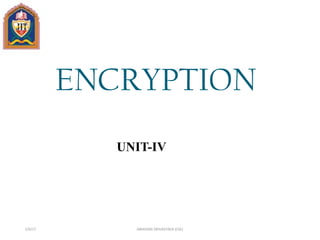This document discusses encryption and provides examples of how encryption is used. It begins by defining encryption as the process of coding text to protect data being transmitted. It then discusses why we use encryption, such as to secure important information like health records, credit card numbers, and student records. The document goes on to describe how encryption works, including the use of keys to encrypt plaintext into ciphertext. Real-life examples of encryption include uses in the military, government, online banking, e-commerce, social media, and more.





















![Authentication & security:
• There is some source A that produces a message in plaintext,
X =[X1, X2,..., XM,]. The M elements of X are letters in
some finite alphabet. The message is intended for
destination B. B generates a related pair of keys: a public
key, PUb, and a private key, PRb. PRb is known only to B,
whereas PUb is publicly available.
•
• A generates another pair of keys: a public key, PUa, and a
private key, PRa. PRa is known only to A, whereas PUa is
publicly available.
Contd.Contd.1/9/17 ABHISHEK SRIVASTAVA (CSE)](https://image.slidesharecdn.com/unit4-170109053926/85/Unit-4-22-320.jpg)
![SECRECY IN A PUBLIC KEY
ENCRYPTION :
Step 1:Step 1: A encrypt the massage using B’s public key PUb andA encrypt the massage using B’s public key PUb and
send it to B.send it to B.
With the message X and the encryption key PUb asWith the message X and the encryption key PUb as
input, A forms the cipher text Y = [Y1, Y2,..., YN]:input, A forms the cipher text Y = [Y1, Y2,..., YN]:
Step 2:Step 2: B decrypt the massage using it’s private key PRb.B decrypt the massage using it’s private key PRb.
Using it’s private key PRb and the cipher text Y itUsing it’s private key PRb and the cipher text Y it
obtain the original massage Xobtain the original massage X
1/9/17 ABHISHEK SRIVASTAVA (CSE)](https://image.slidesharecdn.com/unit4-170109053926/85/Unit-4-23-320.jpg)







![COMPUTATIONAL COST
• It is computationally easy for a party B to generate a pair
(public key PUb, private key PRb).
• It is computationally easy for a sender A, knowing the
public key and the message to be encrypted, M, to
generate the corresponding cipher text:
• C = E(PUb, M)
• It is computationally easy for the receiver B to decrypt
the resulting cipher text using the private key to
recover the original message:
• M = D(PRb, C) = D[PRb, E(PUb, M)]
• It is computationally infeasible for an adversary,
knowing the public key, PUb, to determine the
private key, PRb.
•
1/9/17 ABHISHEK SRIVASTAVA (CSE)](https://image.slidesharecdn.com/unit4-170109053926/85/Unit-4-31-320.jpg)
